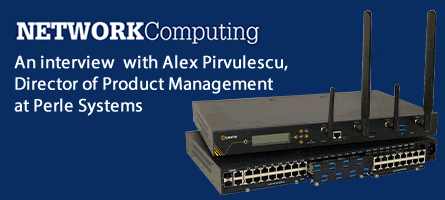Friday, October 14, 2022
Advanced OOBM Tactics Simplify and Reinforce Remote Data Center Access
Modern out-of-band management (OOBM) platforms offer a wealth of new features to aid administrators with zero-touch deployments and robust, failure-resistant remote data center connectivity. Originally posted by Network Computing here.
By Andrew Froehlich

Hybrid and multi-cloud architectures are a way to build redundancy into enterprise infrastructures when a major data center (DC) outage occurs. A caveat to this model, however, resides in the fact that IT departments are beginning to deploy systems in far-off managed data centers and colocations. This is leading to situations where physical, on-site access becomes problematic and expensive.
To counter this risk, many are looking to modern out-of-band management (OOBM) console hardware platforms that offer a wealth of new features to aid administrators with zero-touch deployments and robust, failure-resistant remote DC connectivity. When speed is of the essence, and a lack of on-site support is inevitable, a new approach is essential. Alex Pirvulescu, Director of Product Management at Perle Systems, and an expert in electronics engineering, helps shed light on several OOBM tactics which can be used to simplify and reinforce remote DC OOBM access.
Zero-touch provisioning
Zero-touch provisioning (ZTP) is the concept of shipping hardware and related software to a remote site without the need for localized pre-configuration. Instead, the hardware can be sent directly to the remote DC and can easily be connected and configured remotely. This reduces both the time and cost of deployment.
Zero-touch provisioning has been a popular method of configuring various network and server hardware/software for the better part of a decade. The same is now true for OOBM systems. All it takes is a DHCP server at the remote location to provide the necessary IP, subnet mask, and gateway information to bring the systems online. Once complete, configuration files and firmware updates can be performed directly from the DHCP server or across the internet.

Dynamic routing protocols and VRRP harden OOBM redundancy
It used to be that old OOBM systems simply hung off on the side of network and server gear to provide "backdoor" access. New OOBM console servers, however, can now be positioned in a more centralized location within the network and can be configured to make use of standards-based routing protocols such as OSPF and BGPv4. "The concept here," states Pirvulescu, is that out-of-band management platforms can now be more seamlessly integrated within a data center's core routing layer such that the OOBM system rapidly detects any network failure while also identifying a secondary or tertiary path so that out of band management access is maintained.
Another redundancy protocol, known as Virtual Router Redundancy Protocol (VRRP) - an IETF standard -- can also be configured to provide an extra layer of resiliency. VRRP is commonly found in redundant IP network equipment that allows for seamless failover of two or more identical network routers/switches when a failure of the active system is detected. The network's default gateway and corresponding traffic routing immediately shift to an active working network device to increase the availability of gateway services. This helps guarantee that traffic within the DC can continue to flow. The same VRRP service can also be configured within OOBM platforms so that management is immediately restored when a failure occurs.
Built-in network and system monitoring
"When network failures occur on upstream networking equipment that is several hops away within a data center, it can create a situation where OOBM platforms may not be aware that a fault has occurred and connectivity is lost," says Pirvulescu. OOBM platforms now offer the ability to continuously ping mission-critical systems and can switch their preferred gateway to a number of cascading secondary gateways in order to regain access to those systems that have become unreachable.
This can include access by way of secondary Ethernet ports, Wi-Fi, or LTE.
Eliminating the risk of inaccessible systems
When it comes down to it, all these OOBM tactics can meaningfully reduce the risk that a business would have to spend countless hours and money required to build and manage remote data center devices without the need for on-site support. This is especially important for organizations that have apps/services strewn across a large geographical footprint. While the complexity of an OOBM architecture does increase, it can be a sound trade off when seconds count.
About Andrew Froehlich: https://www.networkcomputing.com/author/andrew-froehlich
As a highly experienced network architect and trusted IT consultant with worldwide contacts, Andrew Froehlich has nearly two decades of experience and possesses multiple industry certifications in the field of enterprise networking. Froehlich has participated in the design and maintenance of networks for State Farm Insurance, United Airlines, Chicago-area schools and the University of Chicago Medical Center. He is the founder and president of Loveland, Colo.-based West Gate Networks, which specializes in enterprise network architectures and data center build outs. The author of two Cisco certification study guides published by Sybex, he is a regular contributor to multiple enterprise IT related websites and trade journals with insights into rapidly changing developments in the IT industry.